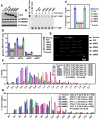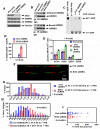Bcl2 induces DNA replication stress by inhibiting ribonucleotide reductase
- PMID: 24197132
- PMCID: PMC3887143
- DOI: 10.1158/0008-5472.CAN-13-1536-T
Bcl2 induces DNA replication stress by inhibiting ribonucleotide reductase
Abstract
DNA replication stress is an inefficient DNA synthesis process that leads replication forks to progress slowly or stall. Two main factors that cause replication stress are alterations in pools of deoxyribonucleotide (dNTP) precursors required for DNA synthesis and changes in the activity of proteins required for synthesis of dNTPs. Ribonucleotide reductase (RNR), containing regulatory hRRM1 and catalytic hRRM2 subunits, is the enzyme that catalyzes the conversion of ribonucleoside diphosphates (NDP) to deoxyribonucleoside diphosphates (dNDP) and thereby provides dNTP precursors needed for the synthesis of DNA. Here, we demonstrate that either endogenous or exogenous expression of Bcl2 results in decreases in RNR activity and intracellular dNTP, retardation of DNA replication fork progression, and increased rate of fork asymmetry leading to DNA replication stress. Bcl2 colocalizes with hRRM1 and hRRM2 in the cytoplasm and directly interacts via its BH4 domain with hRRM2 but not hRRM1. Removal of the BH4 domain of Bcl2 abrogates its inhibitory effects on RNR activity, dNTP pool level, and DNA replication. Intriguingly, Bcl2 directly inhibits RNR activity by disrupting the functional hRRM1/hRRM2 complex via its BH4 domain. Our findings argue that Bcl2 reduces intracellular dNTPs by inhibiting ribonucleotide reductase activity, thereby providing insight into how Bcl2 triggers DNA replication stress.
Figures







References
-
- Herrick J, Sclavi B. Ribonucleotide reductase and the regulation of DNA replication: an old story and an ancient heritage. Mol Microbiol. 2007;63:22–34. - PubMed
-
- Xue L, Zhou B, Liu X, Heung Y, Chau J, Chu E, et al. Ribonucleotide reductase small subunit p53R2 facilitates p21 induction of G1 arrest under UV irradiation. Cancer Res. 2007;67:16–21. - PubMed
-
- Nordlund P, Reichard P. Ribonucleotide reductases. Annu Rev Biochem. 2006;75:681–706. - PubMed
Publication types
MeSH terms
Substances
Grants and funding
LinkOut - more resources
Full Text Sources
Other Literature Sources

